And to think that I saw it on Vanderlip Drive

Katrina Vanderlip with Havanese Natasha and Nyah. Photo
Can the legacy of Villa Narcissa be preserved?
Few of us have had the pleasure of sifting through family papers and finding original artwork by Dr. Seuss, but that’s what happened to Katrina Vanderlip a few weeks ago. Then again, her parents had been friends with illustrator-author Dr. Seuss and his wife, which is to say, Ted and Helen Geisel.
Katrina is an art conservator who lives on Long Island. Along with siblings Kelvin Jr., Narcissa, and Henrik, she is a child of Kelvin and Elin Vanderlip, and grandchild of Frank A. Vanderlip, the New York banker who purchased 16,000 acres of the Palos Verdes Peninsula a little over 100 years ago. A grand estate in Portuguese Bend was envisioned that would have rivaled Hearst Castle or the Getty Villa, but the Great Depression curtailed efforts to bring it to fruition. Even so, some projects were begun, one of which, conceived as a guest house called the Villetta, was long ago christened the Villa Narcissa (after grandfather Frank’s wife). It remains the key structure on the present estate, now somewhat under 12 acres.
“I was sorting through plans of the house,” Katrina says, sitting in the Villa’s living room, “because they were sort of in a mess. I wanted to roll them up properly and repair some tears. There were a lot of plans for the big villa that was never built.” That would have been the Villa Palos Verdes, modeled on the grandiose Villa Giulia, built in 1551-1553 for Pope Julius III in Rome.
“Suddenly in the middle of it I came across this plan and I unrolled it.” To her sister Narcissa, she said: “Isn’t this fun?” “You know, that looks like Uncle Ted’s art,” Narcissa replied. Katrina checked again, and sure enough, it was his work.
“It’s been hidden away for a long time,” she says.
What they uncovered was one of the many renderings for the house and its spacious surroundings, executed by an architect around 1949. What Dr. Seuss contributed to the plan were incidental sketches, which certainly lend some humor and charm to the large sheet.
“My dream is to make it into a poster,” Katrina says. “But it would be fun to make tablecloths out of it because it’s a fun image.”
Ted Geisel had been friends with Kelvin Vanderlip on the East Coast and, after Vanderlip moved into the Villa, Ted and Helen came out to visit. Eventually, the Geisels moved to La Jolla. “But they would come here regularly on weekends,” Katrina says.

Wildlife on the Hill.” Illustration by Ted Geisel (Dr. Seuss)
Geisel was the godfather of Katrina’s older brother, Kelvin Jr., and the boy was the beneficiary of numerous illustrations. One of them, which hung over his bed, was a key image from “McElligot’s Pool.” Some of the watercolors for this book were painted at Villa Narcissa.
Katrina recounts a visit to the Geisels’ La Jolla home when she was about six years old: “I loved drawing, so he (Dr. Seuss) explained to me how he did his drawings and the colors. It was my first contact, and my first contact for years with an actual artist or somebody illustrating a book, and it always stuck with me.”
Katrina then shares a letter written by the Geisels to her father in 1955, one year before he died, still only in his mid-40s. After a few moments, she says, “Theirs was a very close and loving friendship.”
Magnificent parties
The sketches that Ted Geisel drew on the architectural rendering of the Vanderlip estate were in advance of one of the many elaborate parties often organized by Katrina’s parents. Chief among them were the costume parties.
“The one I love the name of best was the Borgia Orgia,” Katrina says. “For the Borgia Orgia, the invitation went out three months ahead of time, saying that they were assembling poisons from India and other places. Then (on a follow-up reminder) they’d say it’s on a camel train and they’re going through Damascus. There was this whole thing building up to the party, and (invitees) would get weekly letters that were full of jokes.

Gardens planted by Elin Vanderlip include these Pride of Madeira. Photo courtesy of Katrina Vanderlip
“By the time the party came everybody was in costume and everybody had a role, and we have these incredible snapshots from every year.” There might be drinks served at the Temple at the top of the cypress allee, at least for those with the stamina to climb the 260 steps, and then dinner below, perhaps on the tennis court. “The whole neighborhood participated,” Katrina says, “and there were cars parked all the way down the hill.”
There was a hiatus in the activity at the Villa from 1958 to 1966, when Elin Vanderlip decamped for Europe with her four children after the death of her husband. Upon their return, the gatherings resumed, often with well-known people in attendance. Random Lengths editor and publisher James Allen, attending Rolling Hills High School at the time, was surprised to meet John Kenneth Galbraith, having just read one of his books. Galbraith, whom Elin Vanderlip knew from Switzerland, was asked if he’d mind talking to local high school students. The latter were invited up to the Villa for the occasion.
Other celebrated guests ranged from Queen Noor of Jordan to the King of Norway. Rose Kennedy was at the Villa, just days before her son Robert was assassinated.
A revitalized oasis?
And so to the crux of the matter.
In its heyday, Villa Narcissa played host to important people, from Dr. Seuss to Mrs. Kennedy, and there were gorgeous parties that flowed from the house to the temple and the temple to the terrace. And then there were the gardens, cultivated by Elin Vanderlip and overseen by her up until her death 10 years ago at the age of 90.
This could all be in danger of slipping away because there are expenses and upkeep. What Katrina hopes to do, and this is why we spoke at length about Ted Geisel and his connection to the family, is to continue the tradition and ensure that the estate stays within the family and its descendants as long as possible.
She’d like it to remain a place for parties, albeit on a smaller and more reasonable scale, and furthermore, she’d like the Villa to become a haven for cultural events. Katrina mentions the Long Beach Opera (she has a friend on the board), and the idea of the company presenting an intimate, perhaps chamber-sized work, “just for 50-75 people, with just one or two singers.” Possibly, she adds, people could be shuttled in from the Abalone Cove parking lot, on evenings when it’s uncrowded, “so it doesn’t bother the neighborhood.”
Entirely feasible, in these eyes, and I’m remembering Long Beach Opera’s waterfront staging of “King Gesar,” composed by Peter Lieberson, billed as a “campfire opera,” and starring the talented Roberto Perlas Gomez and Danielle Marcelle Bond. How enchanting it would be with a panoramic view of the coastline behind them.
Katrina also mentions the Long Beach Symphony, which could perform on the terrace. She envisions, too, culinary events with notable chefs. There already have been opera teas and of course, the plein air painting weeks that take place each spring, the classes given by Daniel Pinkham and Katrina herself.
The notion and desire of “continuing the tradition” come up often in our conversation, and of course, it must be recalled that Katrina’s mother, Elin Vanderlip, set the bar quite high. First, with Friends of French Art, in which she organized nearly two dozen group excursions over two decades; the foundation’s purpose being to raise money for cultural restoration work in France, both architectural (a mill where Pissarro had painted, the balcony of a house on the Seine painted by Manet and Monet, etc.) and artistic (e.g, the conservation of tapestries).
Second, as noted, Elin Vanderlip planted the gardens. This is largely where the Vanderlip Heritage Fund comes in, its stated goal the promotion of history, art, and nature, while simultaneously seeking to preserve the house and its environs. Katrina would like for the gardens to be restored and maintained (not always so easy in times of drought), and run as a non-profit “so I can get grants to recreate and put the garden back in shape the way it was.”

Eric de Carbonnel looks through drawings for the Vanderlip estate drawn by Ted Geisel (Dr. Seuss). Photo by courtesy of Katrina Vanderlip
She wants people, and especially neighbors who live in the quiet gated area below, to understand that any fundraising is not geared to lining her own pockets: “None of this is going to me or to my children, it’s going towards preserving what I think is important. I’m an art restorer. I’ve been preserving things all of my life. Now it’s time to preserve this, which is the history of the Peninsula.”
And not only the history, but as was recently pointed out to her, “the heart and soul of the Peninsula.”
Oddly enough, it was a “disastrous” event that has helped keep this part of Rancho Palos Verdes in somewhat pristine condition. In the 1950s, road construction at the top of the hill started a landslide to the south of Villa Narcissa, and to this day the earth is still moving towards the ocean. “If the landslide hadn’t happened,” Katrina says, “there wouldn’t have been a moratorium on building, and there wouldn’t be the Palos Verdes Land Conservancy. It’s unbelievable that we still have bare hills around here, so it still looks the same (as it did a century ago).”
Another unfortunate event may, in the end, have had a fortunate outcome. If the Villa Palos Verdes had been built, especially on the grand scale as envisioned by Frank Vanderlip, his heirs most likely would not have been able to keep it. But what happens if the family can’t hold onto the present estate? There would be no guarantee that harsh changes wouldn’t occur.
“What if it got sold to some sports fan who has wild parties?” Katrina says. “Then nobody control anything or the inside will be gutted and all the history will be gone. It would be tragic.”
To keep and revitalize Villa Narcissa and its gardens, to maintain it as a sanctuary from the urban sprawl and to promote it as an oasis of cultural events, is a noble endeavor. Katrina Vanderlip would be doing a favor to the community, ours and others, if she’s successful. Does she have the tenacity her mother had? There’s that legacy and, let’s not forget, perhaps we really are talking about the heart and soul of the Peninsula.
For more information email katrinavanderlip@yahoo.com and visit villanarcissa.com/vanderlip-heritage-fund/.

